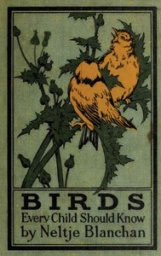

Birds Every Child Should Know (1907)
by Neltje Blanchan


Why don't they fall off? If you ever have a chance, examine their claws. These, you will see, are very much curved and have sharp little hooks that catch in any crack or rough place in the bark and easily support the bird's weight. As a general rule the chickadee keeps to the end of the twigs and the smaller branches; the tufted titmouse rids the larger boughs of insects, eggs, and worms hidden in the scaly bark; but the nuthatches can climb to more inaccessible places. With the help of the hooks on their toes it does not matter to them whether they run upward, downward, or sidewise; and they can stretch their bodies away from their feet at some very queer angles. Their long bills penetrate into deep holes in the thick bark of the tree trunks and older limbs and bring forth from their hiding places insects that would escape almost every other bird except the brown creeper and the woodpecker. Of course, when you see any feathered acrobat performing in the trees, you know he is working hard to pick up a dinner, not exercising merely for fun. The most familiar nuthatch, in the eastern United States, is the one with the white breast; but in the Northern States and Canada there is another common winter neighbour, a smaller compactly feathered, bluish gray gymnast with a pale rusty breast, a conspicuous black line running apparently through his eye from the base of his bill to the nape of his neck, and heavy white eyebrows. This is the hardy little red-breasted nuthatch. His voice is pitched rather high and his drawling notes seem to come from a lazy bird instead of one of the most vigorous and spry little creatures in the wood. The nasal ank-ank of his white-breasted cousin is uttered, too, without expression, as if the bird were compelled to make a sound once in a while against his will. Both of these cousins have similar habits. Both are a trifle smaller than the English sparrow. In summer they merely hide away in the woods to nest, for they are not migrants. It is only when nesting duties are over in the autumn that they become neighbourly.🏁
Global Leaderboard
| # | Player | Time | Duration | Accuracy | WPM | pp | |
|---|---|---|---|---|---|---|---|
| 1 | |||||||
| 2 | |||||||
| 3 | |||||||
| 4 | |||||||
| 5 | |||||||
| 6 | |||||||
| 7 | |||||||
| 8 | |||||||
| 9 | |||||||
| 10 |


Why don't they fall off? If you ever have a chance, examine their claws. These, you will see, are very much curved and have sharp little hooks that catch in any crack or rough place in the bark and easily support the bird's weight. As a general rule the chickadee keeps to the end of the twigs and the smaller branches; the tufted titmouse rids the larger boughs of insects, eggs, and worms hidden in the scaly bark; but the nuthatches can climb to more inaccessible places. With the help of the hooks on their toes it does not matter to them whether they run upward, downward, or sidewise; and they can stretch their bodies away from their feet at some very queer angles. Their long bills penetrate into deep holes in the thick bark of the tree trunks and older limbs and bring forth from their hiding places insects that would escape almost every other bird except the brown creeper and the woodpecker. Of course, when you see any feathered acrobat performing in the trees, you know he is working hard to pick up a dinner, not exercising merely for fun. The most familiar nuthatch, in the eastern United States, is the one with the white breast; but in the Northern States and Canada there is another common winter neighbour, a smaller compactly feathered, bluish gray gymnast with a pale rusty breast, a conspicuous black line running apparently through his eye from the base of his bill to the nape of his neck, and heavy white eyebrows. This is the hardy little red-breasted nuthatch. His voice is pitched rather high and his drawling notes seem to come from a lazy bird instead of one of the most vigorous and spry little creatures in the wood. The nasal ank-ank of his white-breasted cousin is uttered, too, without expression, as if the bird were compelled to make a sound once in a while against his will. Both of these cousins have similar habits. Both are a trifle smaller than the English sparrow. In summer they merely hide away in the woods to nest, for they are not migrants. It is only when nesting duties are over in the autumn that they become neighbourly.🏁